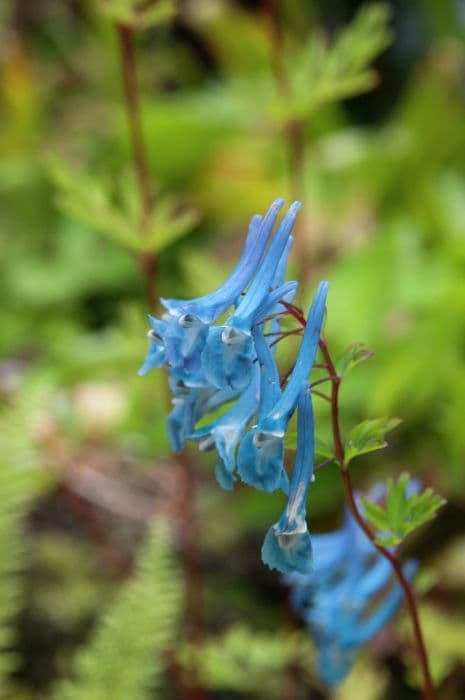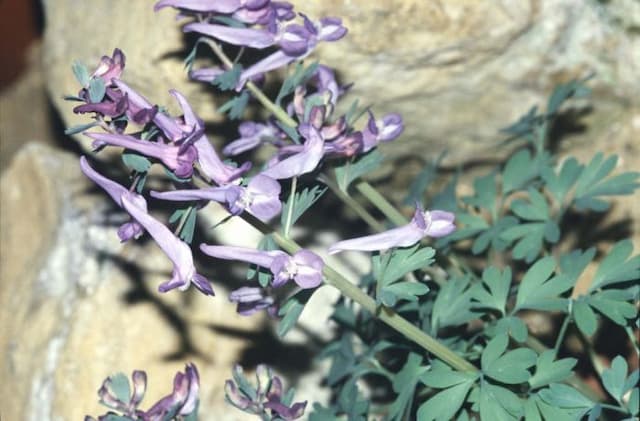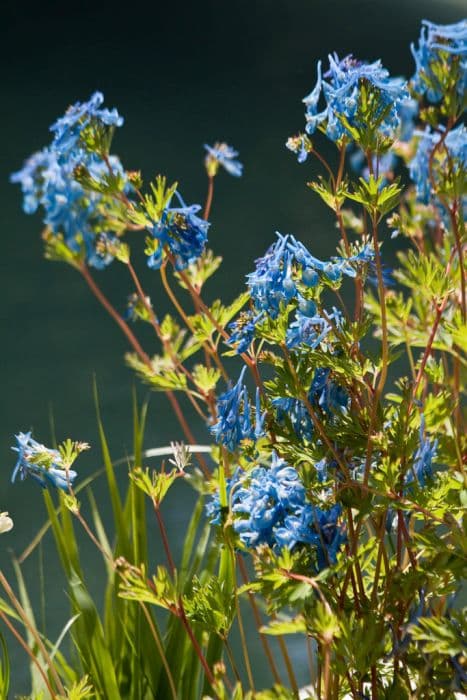Schangin corydalis Corydalis schanginii subsp. ainii

ABOUT
The plant known as Corydalis features delicate, lacy foliage that is often a bright bluish-green. The leaves are dissected, meaning they are divided into smaller segments giving them a feathery appearance. During its blooming period, it produces clusters of tubular flowers which can vary in color from pale pastels to more vivid hues, with some displaying a soft yellow. The blossoms are notable for their spurred shape, giving them an almost whimsical appearance as if they were tiny winged creatures perched among the fern-like leaves. The entire plant presents a soft, almost ethereal effect in the garden, with its intricate leaves and charming flowers creating a delicate texture and a splash of color.
About this plant
 Names
NamesSynonyms
Aini Corydalis, Aini Fumewort
Common names
Corydalis schanginii subsp. ainae, Corydalis schanginii var. ainae.
 Toxicity
ToxicityTo humans
As of my last update, there is limited specific information about the toxicity of Corydalis schanginii subsp. ainii to humans. This plant belongs to the genus Corydalis, some members of which contain alkaloids that can be toxic if ingested in significant quantities. Known symptoms from Corydalis species in general might include sedation, disorientation, and gastrointestinal distress. Consuming parts of the plant could potentially result in these adverse effects. It is essential to note that the reaction to such plants can vary significantly between individuals, and any suspected poisoning should be treated immediately by consulting a healthcare professional.
To pets
The toxicity of Corydalis schanginii subsp. ainii to pets is not well-documented in sources available up to my last update. Corydalis species generally contain alkaloids that can be potentially harmful to animals if ingested. Pets that consume parts of this plant could experience symptoms such as lethargy, gastrointestinal upset, tremors, or ataxia. The severity of symptoms can vary based on the amount ingested and the sensitivity of the individual pet. If you suspect your pet has ingested this plant, it is crucial to seek immediate veterinary care.
 Characteristics
CharacteristicsLife cycle
Perennials
Foliage type
Deciduous
Color of leaves
Green
Flower color
Blue
Height
1 foot 2 inches (35 cm)
Spread
1 foot (30 cm)
Plant type
Herb
Hardiness zones
5
Native area
Central Asia
Benefits
 General Benefits
General Benefits- Aesthetic Appeal: Adds vibrant color and delicate texture to gardens.
- Habitat Support: Offers nourishment and shelter to various insects.
- Ecosystem Diversity: Contributes to the biodiversity of the area.
- Soil Improvement: Its roots may help in soil structure and fertility.
- Pollinator Attraction: Flowers can attract bees and butterflies, which are vital for pollination.
- Low Maintenance: Once established, may require minimal care, fitting well in low-maintenance gardens.
 Medical Properties
Medical Properties- This plant is not used for medical purposes.
 Air-purifying Qualities
Air-purifying QualitiesThis plant is not specifically known for air purifying qualities.
 Other Uses
Other Uses- Corydalis schanginii subsp. ainii can be used as a natural dye for fabrics, imparting a range of colors depending on the mordants used in the dyeing process.
- The plant's foliage may be used in floral arrangements to provide a delicate and feathery green contrast to other flowers.
- It has potential as a modest ornamental ground cover in rock gardens or alpine settings due to its attractive foliage and flowers.
- Corydalis can be used in educational settings such as biology classes to study plant structure and adaptation in mountainous environments.
- Its seeds may serve as a food source for certain bird species, particularly finches, in the wild.
- Gardeners can use the plant as a means of attracting pollinators such as bees and butterflies to their gardens.
- The plant's ability to survive in harsh, rocky conditions can be harnessed for soil stabilization or erosion control in certain landscaping projects.
- Creative craftspeople may use dried specimens of Corydalis schanginii subsp. ainii to create botanical art pieces or for inclusion in pressed flower crafts.
- The plant plays a role in ecological studies by serving as part of a biodiverse understory in woodland and forest-edge environments.
- Due to its unique appearance, Corydalis schanginii subsp. ainii could potentially be used in themed gardens designed to mimic the flora of Central Asia.
Interesting Facts
 Feng Shui
Feng ShuiThe plant Corydalis is not used in Feng Shui practice.
 Zodiac Sign Compitability
Zodiac Sign CompitabilityThe plant Corydalis is not used in astrology practice.
 Plant Symbolism
Plant Symbolism- Endurance: Corydalis, also known as Fumewort, often symbolizes endurance as it can grow in tough conditions and persists through the seasons.
- Adaptability: As a plant that can adapt to various environments, Corydalis schanginii subsp. ainii represents the ability to thrive in diverse situations.
- Perseverance: The perseverance of this plant through different climates and soils conveys a message of persistence against adversity.
- Hope: The blooms of Corydalis bring a sense of hope and joy as they emerge, often in early spring, symbolizing new beginnings and optimism.
 Water
WaterThe Fumewort, as Corydalis schanginii subsp. ainii is commonly known, prefers to be kept consistently moist. It should be watered thoroughly when the top inch of soil feels dry to the touch, which might be approximately once a week depending on environmental conditions. Typically, this would amount to around 16 to 32 ounces of water per plant during each watering session. During the growing season in spring and summer, watering frequency should be regular, while in the dormant period of fall and winter, watering should be reduced to prevent overwatering.
 Light
LightFumewort thrives best in partial shade to full shade conditions. It should be placed in a location where it can receive dappled sunlight or in an area that gets bright, indirect light. Avoid exposing the plant to direct afternoon sun, which can be too intense and lead to leaf scorch.
 Temperature
TemperatureThe Fumewort prefers moderate temperatures and should be kept in an environment that typically ranges between 50°F and 75°F. It can survive minimum temperatures down to around 40°F and maximum temperatures up to about 80°F. However, it is vital to protect it from frost and extreme heat, as both conditions can be detrimental to the plant's health.
 Pruning
PruningFumewort requires minimal pruning, mainly to remove spent flower stems or to maintain the desired shape and size. Pruning is best done after the blooming period, typically in late spring or early summer. Regular removal of dead or yellowing leaves can also help to keep the plant healthy and prevent disease.
 Cleaning
CleaningAs needed
 Soil
SoilFor Corydalis (Fumewort), the best soil mix is well-draining with a significant component of grit or perlite to enhance drainage. Organic matter, such as leaf mold or compost, should be mixed in to retain some moisture. The soil pH should range from neutral to slightly acidic, around pH 6.0 to 7.0 for optimal growth.
 Repotting
RepottingFumewort should generally be repotted every 2 to 3 years to replenish the soil and remove any built-up salts. It's best to repot in the spring before the onset of active growth.
 Humidity & Misting
Humidity & MistingFumewort plants thrive in moderate to high humidity levels, ideally around 50% to 70%. They should not be placed in overly dry conditions as it may hinder their growth.
 Suitable locations
Suitable locationsIndoor
Provide bright light, cool temp, no direct sun.
Outdoor
Partial shade, cool soil, protect from hot sun.
Hardiness zone
5-9 USDA
 Life cycle
Life cycleCorydalis schanginii subsp. ainii, commonly referred to as Schangin's corydalis, begins its life cycle as a seed that germinates in late winter to early spring in its preferred habitat, often rocky slopes and woodland areas. Upon germination, the seedling develops a root system and foliage, emerging as a small rosette. As growth progresses, it forms a flowering stem and blooms with tubular flowers, usually in shades of yellow or red, characteristic of the Corydalis genus. After pollination, which is often facilitated by insects like bees, the plant sets seed contained within capsules that, when mature, dehisce and release seeds to the surrounding environment. The plant is perennial and will enter a dormancy period during adverse conditions such as extreme cold or heat, ceasing above-ground growth. In subsequent seasons, the plant re-emerges from its underground tuber or rhizome, completing its life cycle and potentially spreading through both seed dispersal and vegetative reproduction.
 Propogation
PropogationPropogation time
Spring
Propogation: Corydalis schanginii subsp. ainii, more commonly known as Fumewort, is a perennial plant that can be propagated through division. The most popular method involves dividing the plant's rhizomes, which should ideally be done in early spring or autumn when the plant is not in active growth. To propagate by division, carefully dig up the plant, ensuring to keep as much of the root system intact as possible. Gently separate the rhizomes, making sure each division has at least one growth point or bud. Replant the divisions immediately, at the same depth they were growing previously, spacing them about 12 inches (approximately 30 centimeters) apart to allow room for growth. Water the newly planted divisions thoroughly to help establish them. This method of propagation allows for the Fumewort to spread and fill in garden spaces, while also rejuvenating older plants that have become too large or crowded.









